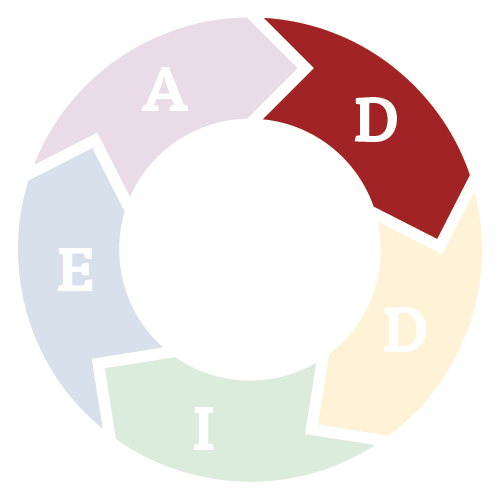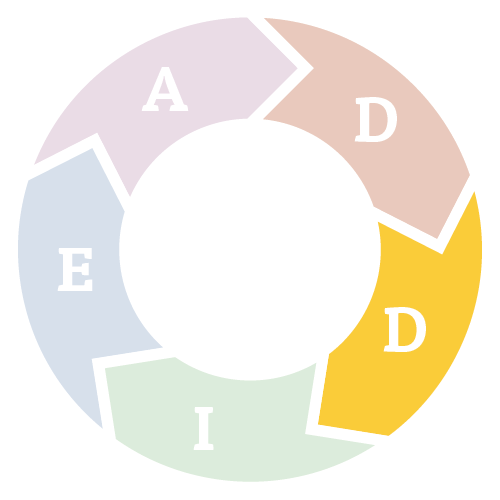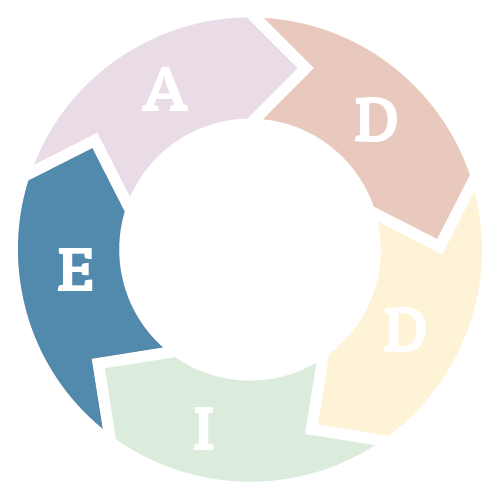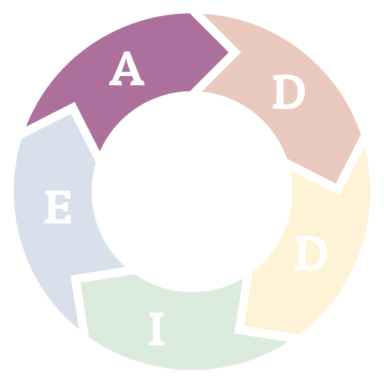The ADDIE model takes its name from the steps involved. ADDIE instructional design, also known as A.D.D.I.E. methodology, is built around the steps of analysis, design, development, implementation and evaluation. The ADDIE training model is similar to the Kirkpatrick model in that it uses a structured process to evaluate training programs. In other words, the ADDIE method is an instructional design model intended to offer a framework for the building and assessment of instructional design.
The ADDIE model of instructional design was one of the first instructional design models developed and quickly became a gold standard. Now the ADDIE training method is widely used to provide a skeleton for all types of instructional design materials creation, and the ADDIE training model is used around the world in teaching instructional design.
New instructional designers or trainers wondering what the ADDIE process can read on for an in-depth look at its component parts. We will describe each phase of the ADDIE model so that you understand what each component entails. Feel free to save this page for your records so that any time you need a quick refresher you’ve got one at hand. That said, onward!

Analysis phase
The first and arguably most important phase in the ADDIE model is the analysis phase. The ADDIE model analysis phase is where you will gather all of the information you have at the outset of the project to define your approach.
This information includes:
- Instructional objectives, or what you wish to teach to the students
- Who the learners are, their abilities and circumstances
- The setting and model of information delivery (online, classroom, workplace?)
- Teaching considerations and barriers to learning
- The timeline you’re working with
Keep in mind that although ADDIE model evaluation is its own step, it also comes into play at every step along the way. Because the ADDIE model was designed to be flexible and useful in all types of training materials development, it is important that instructional designers are able to modify their plans and their progress at any stage. Therefore, once you have clarified your objectives, your main student profile, your learning environment, your desired outcomes and so on, it is time to sit back and reflect on each.
Questions to ask yourself include: Have I correctly identified who the target student is? Are the instructional objectives in line with the training materials? Are the instructional objectives in line with the student’s starting point, or ability to grasp the materials? And will they be useful in the student’s line of work or for the tasks they must perform on a daily basis? Of course, this is just a sampling of questions. Try to come up with an exhaustive list, then check all the profiles and information you developed in the ADDIE model analysis phase against these questions.
If anything doesn’t jive, fix it before moving on. The ADDIE analysis phase is your foundation, so you want to get it right.

Design phase
The design phase of ADDIE is where you will take all the information you accumulated above and start using it to define an approach to teaching the desired materials to learners. ADDIE design is a systematic method for putting various teaching tools in place to create an overall approach to individual lessons and subject matter as a whole. In the ADDIE model design phase, you will begin to define concrete components of the training plan you will develop.
These include:
- Learning objectives, which are similar to instructional objectives, but detail what the student should learn rather than what the materials should teach (for instance, if you want to teach use of a program, the students should learn to boot it up, open files, perform tasks, save files, etc.)
- Assessment instruments, or what you will use to ensure student learning is on track (i.e. written tests, reflections, performance tests)
- Content and exercises
- Lesson planning
- Media selection, or how you will get the information to the student
The ADDIE model design phase includes figuring out exactly what materials you will use to transmit the learning materials, how you will design them, and even what they will look like. Furthermore, the design phase in training materials development requires that instructional designers think hard about how the students will interact with the materials and what they will do with the learning they acquire. Only by thinking through these issues can training developers actually come up with the correct materials for the job.
In this phase, you will also create a prototype for the training program. This will make it easier to evaluate it and see if it meets all the needs you established for your learners in the analysis phase. If anything is lacking, fix it before moving on to actually developing the materials.

Development phase
The ADDIE model development phase builds on the design step in several ways. Developers will build out the prototype, creating actual materials as planned in the previous phase. This step is crucial because if instructional designers fail to create appropriate materials for students to use and learn from, they may fail in meeting their learning objectives. Even if a design reads fabulously on paper unless it is executed well, the entire training process may flop.
Therefore, the ADDIE development phase is a foundational step in the process, ensuring that the information gathered in the analysis phase and utilized in the design phase is adequately transmitted to students in the implementation phase. In many ways, the entire ADDIE model hinges on this step. It is important that designers be systematic when transmitting designs to actual content, graphics and materials.
In a nutshell, ADDIE development includes:
- Creating the actual content that learners will receive throughout the course of instruction
- Creating storyboards of how content will be presented
- Building out exercises and other materials that students will use to aid in their learning
- Creating e-learning materials, if distance or online learning is involved
- Building the technological platforms that will be used
- Planning for and integrating all technology intended for inclusion in the training program
This phase of the ADDIE model also requires testing and debugging all planned materials to make sure they flow well, don’t contradict one another and work as intended. In the case of technology, programmers should test programs to ensure their proper function, and in the case of content, editors should carefully review it for accuracy and pedagogical effectiveness.
As with every other phase of the ADDIE model, it is crucial to evaluate how well this phase will meet the overall instructional objectives and student needs before moving on to implementation.

Implementation phase
ADDIE implementation is the phase in which learners actually receive the instruction and materials prepared for them throughout the previous three steps of the ADDIE model. As such, it is arguably the most important step because it is where the learning actually occurs. While delivery of the course to the learners is no longer officially in your hands, you can use ADDIE model implementation to determine whether or not your design process was a success, where you can improve, and how better to approach the rest of the model in future.
During the implementation phase, instructional designers hand off their materials to the instructors who will actually be teaching the course. Before you do this, you will develop a training program to teach instructors how best to use the course materials, instruct them in the learning outcomes, facilitate their use of technology and familiarize them with testing. In this way, you can bring the instructors up to speed on the materials to give them the best chance of transmitting them effectively.
Beyond that, however, the ADDIE model implementation phase is an excellent opportunity to see how learners actually receive the materials. By observing, you can take notes on how well objectives are met, how closely the course sticks to the predicted timeline, and what learners get out of it.
This phase is also when you should evaluate how easy it is for learners to access the materials. If they are learning in a classroom, for instance, does the technology work as planned and are students able to effectively interact with the literature and exercises? If the information is being transmitted via e-learning platforms, is it effective? Are students able to sign up, log in and use materials easily?
Once again, the implementation phase is a chance to evaluate how well materials work for teaching the objectives laid out, before the final and official evaluation phase that occurs next.

Evaluation phase
ADDIE model evaluation happens in many ways throughout the course of this model, and not just in the final stage. As we’ve already discussed, formative evaluation happens in every step. This is where you ask questions related to the content you’re developing with the goal of ensuring that it is meeting your objectives and building successfully on previous steps.
Summative ADDIE evaluation is more formal, and it can really help you see where your process needs more work. Since many training programs are developed and redeveloped over the years for continuous use, this is an important step.
Much of the information you’ll use in the ADDIE model evaluation phase comes from the assessments that instructors delivered to students at the end of their course of training. If you followed the ADDIE model precisely, then you outlined specific instructional and learning objectives in the beginning stages of development. You should now be able to see how well learners met the objectives after receiving the instruction contained in the course materials.
For instance, if one of your instructional objectives was to teach the use of a specific program, you can now use specific assessments to see whether that was effectively taught. Can students boot up the program? Can they navigate to the proper menus? Can they perform certain tasks, save the file, etc.? If so, and your objectives were met, then your training materials in this instance were successful. If learners were unable to meet the objectives, you have a wealth of information to use in determining why that was, including instructors, your own notes and the assessments themselves.
If your objectives were not clear enough from the beginning, you may find you’re having a hard time finding where improvement is needed at the end. In this case, return to the analysis phase and try to be more precise.
Instructional systems design
As you can probably see from the layout of the ADDIE model, the pivotal idea behind instructional design is making the process more accessible by providing exact steps to follow in creating training materials. Also called instructional systems design because of the fact that it follows regimented systems, the instructional design process seeks to make learners’ attainment of new skills and knowledge easier by streamlining the design process and keeping their learning at the forefront.
Many training programs simply collate a whole lot of materials without respect to the learners’ starting points, backgrounds, instructional needs, the learning setting, the barriers to learning both individually and as a group, the instructors to be used, and the organization requiring the training. Although these doubtless transmit some information, they are unlikely to be as effective as instructional design training materials are.
The fundamental disorganization and lack of respect for student needs inherent in such an approach often inhibits learning.
The instructional design process, starting with the ADDIE model as the gold standard of the ISD process, remedies this by using student needs and starting points as the cornerstone on which the rest of the training program is built. A good instructional design uses the individual facets of each organization to define its unique training program, which is why it is so effective.
The other main benefit of using an instructional design process is the simplification it offers to an otherwise overwhelming task: transmitting a large amount of information to a diverse group of people in a short amount of time. Breaking down each step allows for deep thought, excellent design, intentional instruction and a peerless learning process in the end.



